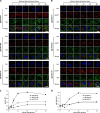High-content analysis of antibody phage-display library selection outputs identifies tumor selective macropinocytosis-dependent rapidly internalizing antibodies
- PMID: 25149096
- PMCID: PMC4256486
- DOI: 10.1074/mcp.M114.039768
High-content analysis of antibody phage-display library selection outputs identifies tumor selective macropinocytosis-dependent rapidly internalizing antibodies
Abstract
Many forms of antibody-based targeted therapeutics, including antibody drug conjugates, utilize the internalizing function of the targeting antibody to gain intracellular entry into tumor cells. Ideal antibodies for developing such therapeutics should be capable of both tumor-selective binding and efficient endocytosis. The macropinocytosis pathway is capable of both rapid and bulk endocytosis, and recent studies have demonstrated that it is selectively up-regulated by cancer cells. We hypothesize that receptor-dependent macropinocytosis can be achieved using tumor-targeting antibodies that internalize via the macropinocytosis pathway, improving potency and selectivity of the antibody-based targeted therapeutic. Although phage antibody display libraries have been utilized to find antibodies that bind and internalize to target cells, no methods have been described to screen for antibodies that internalize specifically via macropinocytosis. We hereby describe a novel screening strategy to identify phage antibodies that bind and rapidly enter tumor cells via macropinocytosis. We utilized an automated microscopic imaging-based, High Content Analysis platform to identify novel internalizing phage antibodies that colocalize with macropinocytic markers from antibody libraries that we have generated previously by laser capture microdissection-based selection, which are enriched for internalizing antibodies binding to tumor cells in situ residing in their tissue microenvironment (Ruan, W., Sassoon, A., An, F., Simko, J. P., and Liu, B. (2006) Identification of clinically significant tumor antigens by selecting phage antibody library on tumor cells in situ using laser capture microdissection. Mol. Cell. Proteomics. 5, 2364-2373). Full-length human IgG molecules derived from macropinocytosing phage antibodies retained the ability to internalize via macropinocytosis, validating our screening strategy. The target antigen for a cross-species binding antibody with a highly active macropinocytosis activity was identified as ephrin type-A receptor 2. Antibody-toxin conjugates created using this macropinocytosing IgG were capable of potent and receptor-dependent killing of a panel of EphA2-positive tumor cell lines in vitro. These studies identify novel methods to screen for and validate antibodies capable of receptor-dependent macropinocytosis, allowing further exploration of this highly efficient and tumor-selective internalization pathway for targeted therapy development.
© 2014 by The American Society for Biochemistry and Molecular Biology, Inc.
Figures








Similar articles
-
Combine Phage Antibody Display Library Selection on Patient Tissue Specimens with Laser Capture Microdissection to Identify Novel Human Antibodies Targeting Clinically Relevant Tumor Antigens.Methods Mol Biol. 2018;1701:331-347. doi: 10.1007/978-1-4939-7447-4_18. Methods Mol Biol. 2018. PMID: 29116514 Free PMC article.
-
Identification of Novel Macropinocytosing Human Antibodies by Phage Display and High-Content Analysis.Methods Enzymol. 2017;585:91-110. doi: 10.1016/bs.mie.2016.10.004. Epub 2016 Dec 1. Methods Enzymol. 2017. PMID: 28109445 Free PMC article.
-
Discovery of internalizing antibodies to tumor antigens from phage libraries.Methods Enzymol. 2012;502:43-66. doi: 10.1016/B978-0-12-416039-2.00003-3. Methods Enzymol. 2012. PMID: 22208981 Free PMC article.
-
Immunotoxins and other conjugates containing saporin-s6 for cancer therapy.Toxins (Basel). 2011 Jun;3(6):697-720. doi: 10.3390/toxins3060697. Epub 2011 Jun 22. Toxins (Basel). 2011. PMID: 22069735 Free PMC article. Review.
-
Bispecific monoclonal antibodies for the targeting of type I ribosome-inactivating proteins against hematological malignancies.Methods Mol Biol. 2001;166:177-92. doi: 10.1385/1-59259-114-0:177. Methods Mol Biol. 2001. PMID: 11217367 Review. No abstract available.
Cited by
-
Novel single-domain antibodies against the EGFR domain III epitope exhibit the anti-tumor effect.J Transl Med. 2020 Oct 6;18(1):376. doi: 10.1186/s12967-020-02538-y. J Transl Med. 2020. PMID: 33023595 Free PMC article.
-
Autophagy and Macropinocytosis: Keeping an Eye on the Corneal/Limbal Epithelia.Invest Ophthalmol Vis Sci. 2017 Jan 1;58(1):416-423. doi: 10.1167/iovs.16-21111. Invest Ophthalmol Vis Sci. 2017. PMID: 28118670 Free PMC article. Review.
-
A neutralized human LMP1-IgG inhibits ENKTL growth by suppressing the JAK3/STAT3 signaling pathway.Oncotarget. 2017 Feb 14;8(7):10954-10965. doi: 10.18632/oncotarget.14032. Oncotarget. 2017. PMID: 28009988 Free PMC article.
-
Combining Phage and Yeast Cell Surface Antibody Display to Identify Novel Cell Type-Selective Internalizing Human Monoclonal Antibodies.Methods Mol Biol. 2015;1319:51-63. doi: 10.1007/978-1-4939-2748-7_3. Methods Mol Biol. 2015. PMID: 26060069 Free PMC article.
-
An E. coli-produced single-chain variable fragment (scFv) targeting hepatitis B virus surface protein potently inhibited virion secretion.Antiviral Res. 2019 Feb;162:118-129. doi: 10.1016/j.antiviral.2018.12.019. Epub 2018 Dec 30. Antiviral Res. 2019. PMID: 30599174 Free PMC article.
References
-
- Ruan W., Sassoon A., An F., Simko J. P., Liu B. (2006) Identification of clinically significant tumor antigens by selecting phage antibody library on tumor cells in situ using laser capture microdissection. Mol. Cell. Proteomics. 5, 2364–2373 - PubMed
-
- Burris H. A., 3rd, Tibbitts J., Holden S. N., Sliwkowski M. X., Lewis Phillips G. D. (2011) Trastuzumab emtansine (T-DM1): a novel agent for targeting HER2+ breast cancer. Clin. Breast Cancer 11, 275–282 - PubMed
-
- Sievers E. L., Senter P. D. (2013) Antibody-drug conjugates in cancer therapy. Annu. Rev. Med. 64, 15–29 - PubMed
Publication types
MeSH terms
Substances
Grants and funding
LinkOut - more resources
Full Text Sources
Other Literature Sources
Miscellaneous

